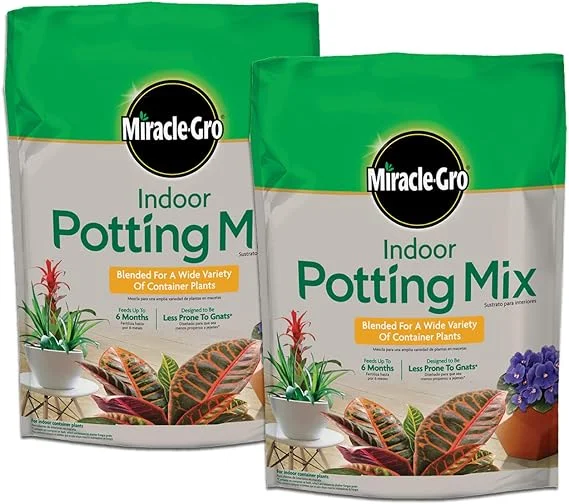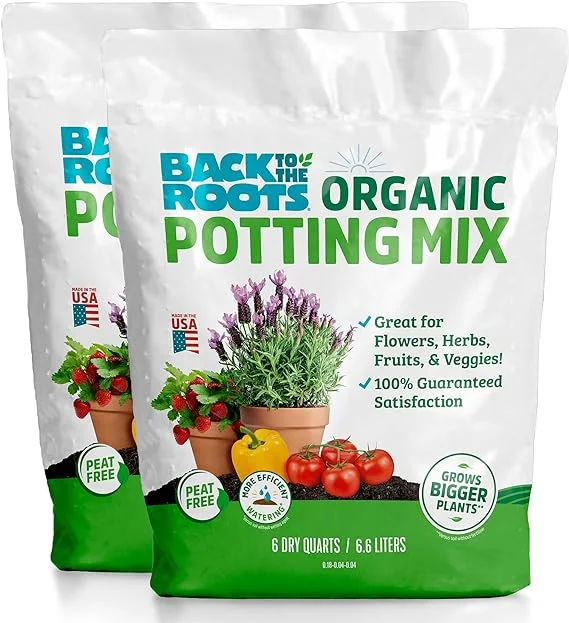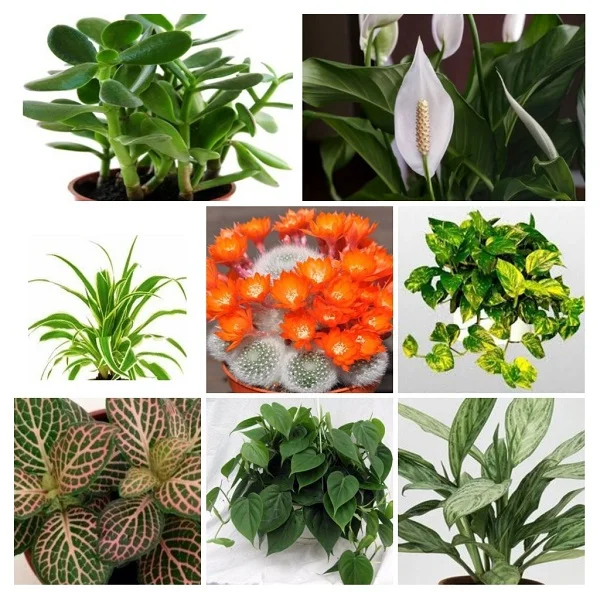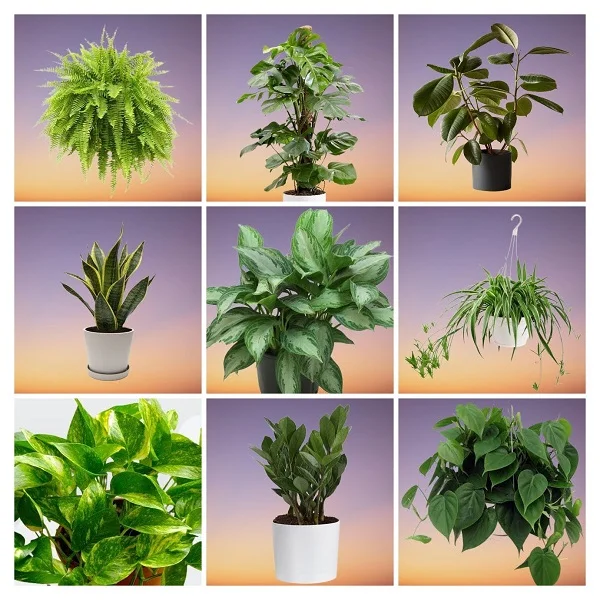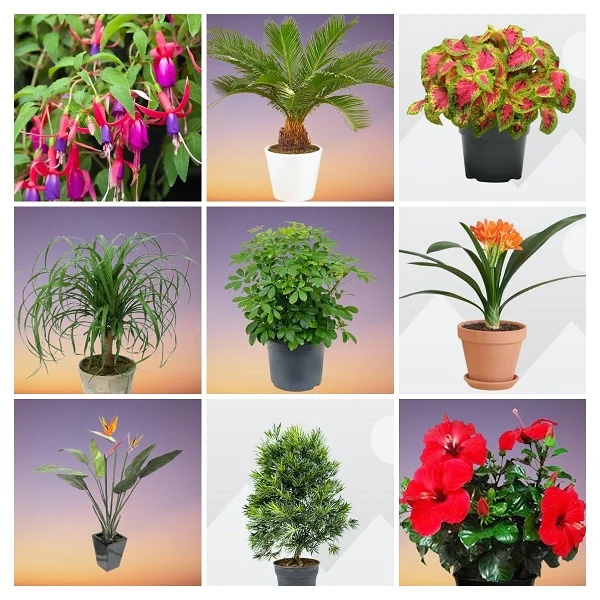Tradescantia pallida (Purple Heart Plant) Indoor Care, Commong Problems and Solutions
Some links in this post may be affiliate links
Tradescantia pallida (Purple Heart Plant) grows best in bright indirect light, average warmth, moderate humidity and moderately moist, rich, free-draining soil coupled with fortnightly feeding in the growing season.
Purple Heart Plant also called Purple Queen Plant is one of the popular Tradescantia varieties on its account of ease of care and ability to adapt to wide range of growing conditions.
Purple Queen Plant bears leaves which are elongated, pointed, slightly hairy, glaucous green, fringed with red or purple placing it among the best purple-leaved plants for the home, office and other places.
Purple Heart Plant flowers are small, sterile, three-petaled and are white, pink or purple. The stems are clearly segmented and roots easily grow from the joints.
Tradescantia pallida which also goes by the botanical names, Setcreasea purpurea and Setcreasea pallida is reknowned for its air cleaning properties.
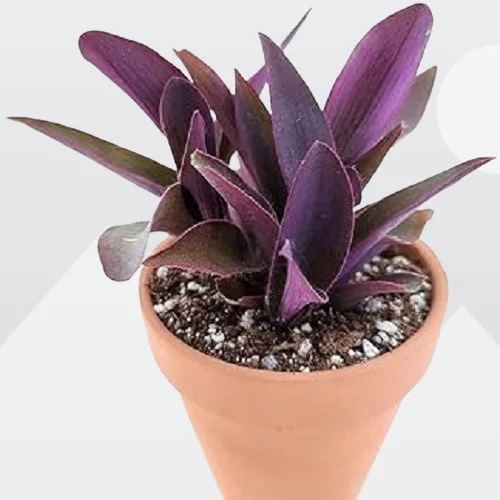
Botanical name: Tradescantia pallida
Synonym: Setcreasea purpurea, Setcreasea pallida
Family: Commelinaceae
Common names: Purple Heart Plant, Purple Queen Plant
Origin
Tradescantia pallida is native to the Gulf Coast of eastern Mexico.
Size
Purple Heart Plant is a small-sized plant which grows to a height of 1-2 feet and a spread of 1-2 feet. It is one of the best plants for the limited spcaes in the home or office.
Invasiveness as a weed
Purple Heart Plants are invasive and noxious weeds in many places. They will successfully grow anywhere and will smoother ground level plants and prevent the natural regeneration of taller species. Avoid planting the plant in the ground and dispose only after complete destruction as even an inch of these plants will sprout if not completely destroyed.
Is Tradescantia pallida toxic?
Yes. Tradescantia pallida is mildly toxic to humans and pets. If ingested, the plant sap can cause burning in the mouth, tongue and throat. The sap may also cause skin irritation in sensitive skin; always wear gloves when handling this plant.
Where to Buy
If you are looking to add the gorgeous Purple Heart Plants to your collection, you may obtain them online from Etsy (Link to Etsy).
How do you care for Tradescantia pallida indoors?
Care for Tradescantia pallida indoors, entails giving it bright indirect light (filtered light), average warmth of 18-270C, moderate humidity of 50-55% and moderately moist, fertile, well-drained soil coupled with fortnightly feeding during the growing season.
Purple Heart Plant needs repotting only when extremely pot-bound as it grows best when slightly root-bound. Regular pruning is needed to keep it neat, to discourage pest and disease infestations, to encourage a bushy, compact growth and to rejuvenate growth. Keep reading for more on the best growing conditions and how to achieve them.
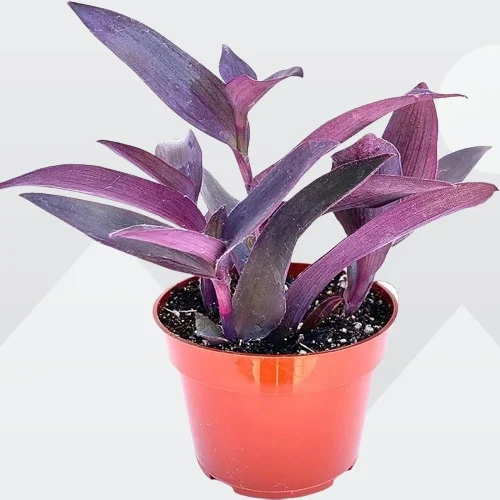
Light Requirements
Do Purple Heart Plants like sun or shade?
Purple Heart Plant does well in bright indirect light. Keep it away from direct sunshine as it can lead to scorching of the leaves.
Too little light will result in leggy growth and yellowing. Therefore, if the natural light is not sufficient, use a full spectrum grow light to supplement it.
Rotate the pot regularly to ensure that the plant receives light on all sides for balanced growth and prevent lopsided growth.
Water Requirements
How often should I water my Purple Heart Plant?
Water your Purple Heart Plant thoroughly in spring and summer while allowing the top 2-3 inches of soil to dry out between waterings. Maintain the soil moderately moist and avoid overwatering which can result in yellowing and rotting.
Cut down on watering in fall and winter to keep the soil slightly moist as growth is minimal. Do not allow the soil to dry out completely to avoid wilting and drooping leaves.
Make sure that the pot has a drainage hole to prevent the soil from getting soggy soil to prevent root-rot and death of the plant.
Temperature and Humidity
Purple Heart Plant requires average warmth of 18-270C. A room temperature that is comfortable for you is ideal for this plant. Keep it away from drafts to avoid sudden flactuations in temperatures as they can cause reduced growth and leaf drop.
Tradescantia pallida has no need for extra humidity. Moderate air humidity of 50-55% is ideal for this plant. However, too dry air will lead to brown, shrivelled leaf tips. Therefore, set the pot on a wet pebble tray to elevate humidity. Maintain proper air circulation to minimize fungal diseases.
Fertilizer
What is the best fertilizer for Purple Heart Plant?
Feed your Purple Heart Plant with a balanced, liquid fertilizer every 2 weeks in spring and summer to promote a healthy growth. Do not feed in fall and winter as the growth is reduced and feeding at this time may lead to fertilizer burn.
Potting Soil
What kind of soil Purple Heart Plant like?
Purple Heart Plant likes a fertile, loose, free-draining soil to prevent waterlogging while providing the required nutrients.
Repotting
Repot Purple Heart Plant during the growing season only when the plant has become extremely pot-bound as it grows best when the roots are confined.
Use a pot one size larger than the current one and ensure that the pot has a drainage hole to prevent the soil from getting soggy as it can lead to root-rot. Check out these ceramic pots with drainage holes and saucer on Amazon.
Pruning & Grooming
Pruning Purple Queen Plant involves regular removal of dead foliage to maintain the plant neat as well as reduce pest and disease infestations.
Pinch off the growing tips to control the growth and make the plant more bushy. Cutback the leggy stems at the beginning of the growing season to rejuvenate growth.
Clean the leaves occasionally by damp-wiping with a soft cloth to keep them clean as well as discourage pest and disease infestations.
Tradescantia pallida Propagation
Tradescantia pallida is propagated by plant divison or from stem cuttings in spring to early summer when it is in active growth. The stem cuttings can be rooted in either in water or in soil.
Learn how to propagate Tradescantia pallida (Purple Heart Plant) by 3 methods.
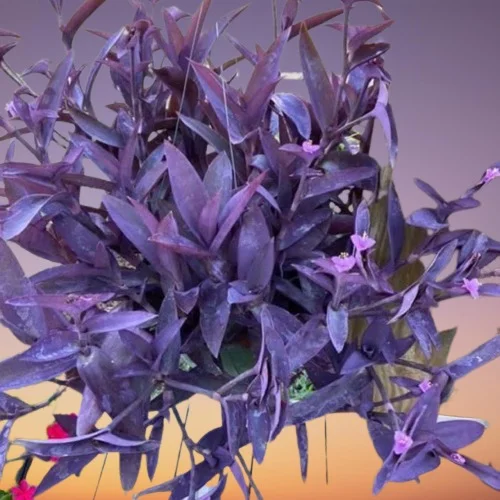
Tradescantia pallida Problems & Remedies
Purple Heart Plant problems are brown leaves, plant dying, curling leaves, loss of leaf color, yellowing leaves, leggy growth, brown leaf tips, drooping leaves, pests and diseases among others. Keep reading for more on these problems and how to fix them.
Brown leaves
Why are the leaves on my Purple Heart Plant turning brown?
The main causes of brown leaves on your Purple Heart Plant are inconsistent watering, soggy soil, and temperature stress.
How to fix it
Inconsistent watering: Do not water on a schedule. Water when the top 2-3 inches dry out. Never allow the soil to dry out completely.
Soggy soil: Use a pot that has a drainage hole and free-draining soil.
Temperature stress: Keep the plant away from drafts emanating from AC units, drafty windows, heat sources, windy doors and others.
Plant dying
Why is my Purple Heart Plant dying?
Purple Heart Plant is dying due to root-rot which is promoted by soggy soil. It is characterized by yellowing and wilting leaves, rapidly followed by browning and plant collapse.
How do you revive Purple Heart Plant?
- Carefully slip the plant out of its pot and inspect the roots.
- Trim the brown-black, mushy roots and treat the healthy roots with a copper-based fungicidal solution as indicated by the manufacturer.
- Disinfect the pot with the fungicidal solution or use a fresh pot to repot the plant in fresh, free-draining soil.
- Do not water the plant immediately and keep it dry for 5-7 days before you can resume watering.
- Use a pot with a drainage hole and well-draining soil to prevent the soil from getting soggy.
- Decrease watering in fall and winter as growth is slowed at this time; keep the soil slightly moist.
Curling leaves
Why are the leaves on my Purple Heart Plant curling?
The leaves on your Purple Heart Plant are curling due to inconsistent watering, soggy soil, and extreme temperatures.
How to fix it
Inconsistent watering: Do not water on a schedule. Water when the top 2-3 inches dry but do not allow the soil to dry out completely.
Soggy soil: Use a pot that has a drainage hole and well-draining soil.
Extreme Temperature: Keep the plant away from drafts from heat sources, AC units, drafty windows, windy doors among others.
Loss of leaf color
Why is my Purple Heart Plant turning green?
Your Purple Heart Plant is turning green due to too low light. Position the plant in a brighter spot where it will receive bright indirect light or instal a grow light where the natural light is not sufficient for the plant.
Yellowing leaves
Some of the causes of yellow leaves on Tradescantia pallida are overwatering, soggy soil, nutrient deficiency, and temperature stress.
How to fix it
Overwatering: Do not water on a schedule. Water only when the top 2-3 inches of soil dry.
Soggy soil: Use a well-draining potting soil and a pot that has a drainage hole.
Nutrient deficiency: Apply a balanced, water-soluble fertilizer every 2-4 weeks in spring and summer.
Temperature stress: Keep the plant away from drafts coming from hot surfaces, hot air vents, AC units, windy doors among others.
Leggy growth
Leggy growth on Purple Heart Plant is caused by too little light, underwatering, and nutrients deficiency.
How to fix it
Too little light: Move the plant in a brighter spot or use a grow light where the natural light is not enough.
Underwatering: Maintain the soil moist in spring and summer and slightly moist in fall and winter. Never allow the soil to dry out completely.
Overfeeding: Feed the plant with a balanced, liquid fertilizer every 2-4 weeks in spring and summer.
Brown leaf tips
Brown leaf tips on Purple Heart Plant are caused by too dry air, temperature stress and underwatering.
How to fix it
Dry air: To up the humidity, set the pot on a wet pebble tray, use a humidifier or group the plants together.
Temperature stress: Keep the plant away from drafts to avoid extreme temperatures.
Underwatering: Do not allow the soil to dry out completely; water when the top 2-3 inches of soil feel dry.
Drooping leaves
Drooping leaves on Purple Heart Plant are due to underwatering, direct sunlight, extreme temperatures, and pests infestations.
How to fix it
Underwatering: Water when the top 2-3 inches of the soil dry, however, do not let the soilball dry out completely.
Direct sunlight: Keep the plant away from direct sunshine or use a light curtain to filter the sunlight.
Extreme temperatures: Avoid drafts originating from stoves, hot surfaces, AC units, windy doors and windows, hot air vents and others.
Pests infestations: Regularly inspect the orchid for pests and take timely control measures.
Pests
Common pests in Purple Heart Plant are mealybugs, aphids and scale insects.
How to fix it
- Isolate the affected plant to prevent spread to the other plants.
- Treat the infected plant with neem oil or insecticidal soap as per the manufacturers instructions.
- Regularly check underneath the leaves for these pests and carry out timely control measures.
- Maintain the plant properly pruned and raise humidity to discourage pest infestation.
Diseases
Purple Heart Plant is prone to leaf spot disease which is prevalent in overwet conditions coupled with poor air circulation.
How to fix it
- Remove and discard the affected parts to reduce the risk of spread to the rest of the plants.
- Spray the affected plant with a systemic fungicide and ensure to cover all the parts with the fungicidal solution.
- Keep the plant on the dry side, do not mist it and ensure good air flow.
- Use a pot with a drainage hole and well-draining soil.
You liked it? Share on social media.
Related Content
Amazon Associates Disclosure
Homeplantsguide.com is a participant in the Amazon Services LLC Associates Program, an affiliate advertising program designed to provide a means for sites to earn advertising fees by advertising and linking to amazon.com.

